As Connected TV (CTV) continues to gain traction, the mechanics of live CTV ad-serving have become a game-changer for advertisers and broadcasters. But what exactly goes on behind the scenes when you see that perfectly timed ad during your favorite live stream on a brand-new Smart TV?
What is Live CTV Ad-Serving?
First, it is essential to remember that CTV is any internet-connected television that streams video content. Some common CTV devices include Smart TVs, set-top boxes, and streaming devices that transform ‘regular’ TVs into internet-connected devices.
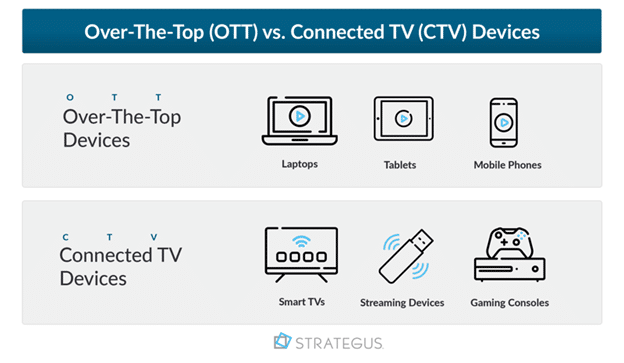
by Strategus
Now, picture yourself immersed in a live broadcast on your favorite CTV platform, and suddenly, an ad appears. But this is not just any ad—it feels like it was made just for you. This is the precision of live CTV ad-serving in action. This dynamic process brings real-time advertisements to linear channels streaming on connected TVs. Unlike traditional broadcast ads, these ads are not just slotted in; they’re carefully selected, inserted, and delivered, ensuring they’re as relevant to you as possible.
The Components of Live CTV Ad-Serving
How does it all work? The magic happens thanks to a few key components working in harmony:
- Ad Server: This is the brain of the operation. The ad server doesn’t just store ads; it makes split-second decisions on which to show you, considering your demographics, viewing habits, and even the content you’re watching.
- Content Delivery Network (CDN): Think of CDNs as the tech that ensures an excellent streaming experience. They deliver live content worldwide and ensure that ads run smoothly.
- Ad Insertion Technology: Have you ever wondered how ads seamlessly appear in your stream without causing a glitch? Thanks to ad insertion technology, particularly Server-Side Ad Insertion (SSAI), which blends ads directly into the content stream, making them unblockable and smooth.
- Ad Decisioning Logic: This is where the real-time magic happens. The decision logic evaluates who you are, what you’re watching, and where you’re located to serve the most relevant ad in milliseconds.
- Measurement and Reporting Tools: After the ad plays, the job must still be done. These tools track everything—from how many times the ad was shown to how many people clicked on it—providing crucial feedback to advertisers.
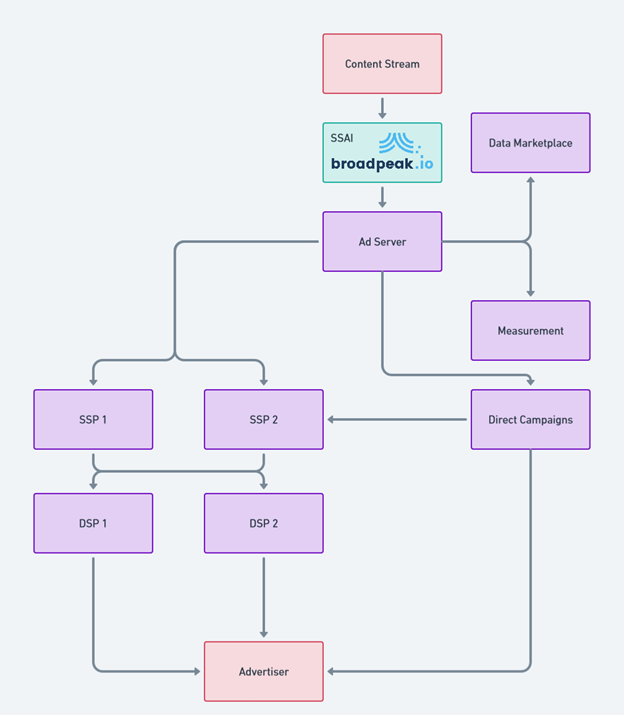
But How Does Live CTV Ad-Serving Actually Work?
Let’s break it down step by step:
- Commercial Pods: Television broadcasts are interrupted by commercial breaks, also known as pods. In some markets, you have national and local spots. Historically, distributors can replace local spots, which can be stripped out and replaced with digitally sold ads. With the advancement of technology and, in particular, Manifest Manipulation, if rights authorize it, even national spots can be replaced and addressable.
- Request and Response: When a viewer starts watching a commercial POD in a live CTV stream, the CTV app sends a request to the ad server for ads through an SSAI (preferable) or a CSAI system. This request includes data about the viewer and the context of the viewing session.
- Ad Selection: The ad server processes the request using the ad decision logic to select the most appropriate ad. Factors considered include the viewer’s demographic profile, past behavior, and the content being watched. It’s important to note that this data is anonymized and used solely for ad selection purposes, respecting the viewer’s privacy.
- Ad Insertion: Once the ad is selected, it is inserted into the live stream. In SSAI, the ad is stitched directly into the content stream on the server side, making it appear as part of the broadcast to the viewer.
- Delivery and Playback: The CDN delivers the combined stream (content + ads) to the viewer. The viewer experiences a seamless transition between content and ads without buffering or interruption.
- Tracking and Reporting: As the ad plays, tracking pixels and other measurement tools collect data on the ad’s performance. This data is returned to the ad server and reporting systems for analysis.
Please note that the information provided is generally applicable. Still, many exceptions depend on the specific relationships between broadcasters, devices, and MVPDs or OTT providers. The entire ecosystem has specific agreements regarding distribution rights and revenue sharing.
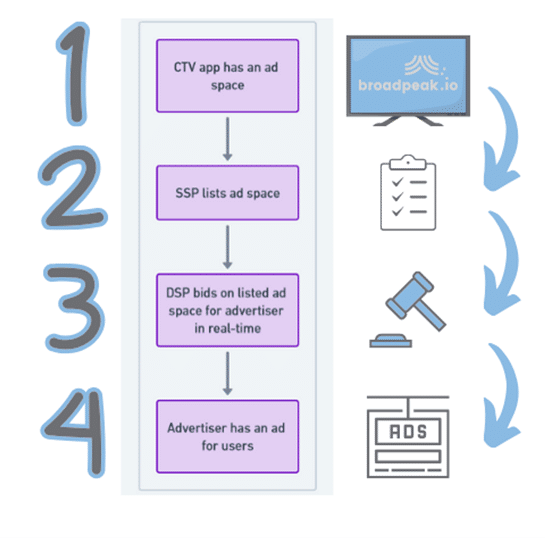
The Role of SSP Auctions In The Mix
Supply-side platforms (SSPs) play a critical role in the live CTV ad-serving ecosystem by managing the ad inventory from various publishers and conducting real-time auctions to sell this inventory to the highest bidder. Here’s how SSP auctions fit into the process:
- Inventory Management: SSPs play a crucial role in the live CTV ad-serving ecosystem by aggregating ad inventory from multiple publishers and DSPs. This ensures a wide range of available ad slots, allowing viewers a diverse and engaging ad experience.
- Real-Time Bidding (RTB): When an ad request is made, the SSP initiates an RTB auction, allowing multiple demand-side platforms (DSPs) and advertisers to bid for the ad slot in real-time. This competitive bidding process helps maximize revenue for publishers and ensures that the most relevant ads are served to viewers.
- Ad Selection: Based on the bids, the SSP selects the highest bidder and serves the corresponding ad to the Ad Server. This decision is made within milliseconds to ensure no delay in the live-streaming experience.
- Ad Delivery: After passing through the Ad Server and SSAI solution, the chosen ad is delivered to the viewer via the CDN, ensuring a smooth and timely display.
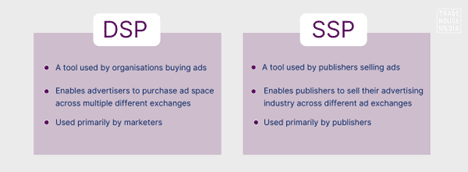
Benefits of Live CTV Ad-Serving
Unlike traditional methods, CTV offers advertisers a powerful toolkit for delivering more targeted, timely, and engaging content. These benefits are reshaping how brands connect with audiences in an increasingly connected world:
- Precise Targeting: CTV advertising allows for highly targeted ad campaigns. Advertisers can target specific demographics, behaviors, and locations, ensuring that suitable ads reach the right audiences.
- Real-Time Optimization: CTV empowers advertisers to adjust and refine their campaigns on the go, using real-time performance data to ensure every ad dollar is spent effectively. This adaptability is a powerful tool for advertisers, allowing them to make the most of their campaigns.
- Enhanced Engagement: Non-skippable CTV ads boast higher completion rates, leading to stronger brand recall and deeper audience engagement than other digital formats. This is the power of CTV to make a lasting impression on viewers.
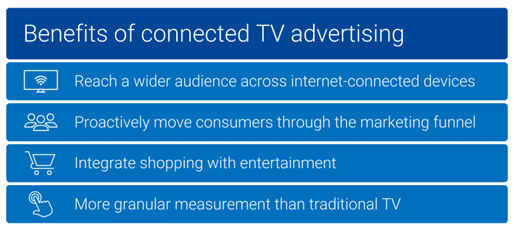
Challenges in Live CTV Ad-Serving
While the benefits are impressive, live CTV ad-serving has hurdles. As the demand for seamless, high-quality ad experiences grows, so do the challenges of delivering them in a live environment. Here are some of the key obstacles that need to be addressed:
- Latency: Ensuring that ads are served in real-time without causing delays in the live stream is a significant challenge. Advanced CDNs and optimized ad insertion technologies are critical in addressing this.
- Ad Relevance: Serving relevant ads live requires sophisticated real-time data processing and decision-making capabilities.
- Viewer Experience: Above all, the viewer’s experience must remain seamless. This means ads must be flawlessly integrated into the live content, avoiding any disruption that could detract from it.
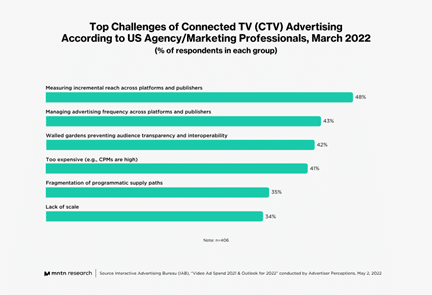
Conclusion
Live CTV ad serving is a complex process that leverages advanced technologies to deliver targeted ads in real-time. As CTV continues to grow, understanding and optimizing these mechanisms will be essential for advertisers and content providers looking to maximize their reach and effectiveness. Contact our team if you need help understanding the steps involved in Live CTV Ad Serving in more detail.










